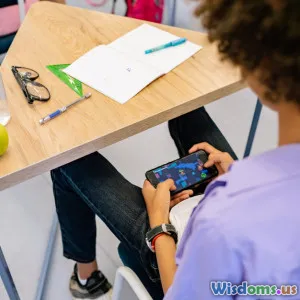
Five Surprising Benefits of Using Educational Apps in Class
9 min read Explore five unexpected advantages of using educational apps in classrooms and how they enhance student engagement, learning outcomes, and collaboration. (0 Reviews)
Five Surprising Benefits of Using Educational Apps in Class
The classroom is no longer bounded by four walls and traditional textbooks. Today, educational technology is transforming lesson plans, making learning more accessible—and exciting—than ever before. While digital devices are sometimes viewed as potential distractions, when harnessed thoughtfully, educational apps can drive student engagement, spark curiosity, and unlock remarkable outcomes. Let’s explore five distinctive benefits that may surprise both educators and students.
Turbocharging Individualized Learning Paths

Creating perfectly tailored lessons for every student might feel unattainable in a bustling classroom. Educational apps, however, are reshaping this reality with adaptive learning features.
How it Works: Many modern apps like DreamBox, Duolingo, or Khan Academy automatically adjust the level of content based on students’ responses, offering extra support or new challenges as needed. This responsive approach ensures advanced learners can accelerate while those needing more time don’t get left behind.
Case Example: At Mission Dolores Academy in San Francisco, incorporating adaptive mathematics apps resulted in students performing an average of 2.4 grade levels above their age group within a single academic year. Teachers found it dramatically easier to pinpoint and close learning gaps since performance data was collected in real-time.
Takeaway Tip: Select platforms that offer actionable analytics and customizable learning tracks, letting you harness app data without drowning in it. Aim for apps that reinforce your curriculum, rather than introduce confusion, for the greatest impact.
Enhancing Collaboration Across Distances and Differences

Gone are the days when group assignments needed to happen strictly in person. Educational apps have made collaboration seamless, even across different time zones or learning styles.
Features That Drive Collaboration:
- Real-Time Co-authoring: Tools like Google Classroom, Padlet, and Book Creator let students co-write documents, brainstorm, or create multimedia presentations irrespective of physical location.
- Chat and Feedback: Discussions aren’t limited to noisy class sessions: apps facilitate structured group chats and threaded comments, including for students who are typically less inclined to participate aloud.
Concrete Example: During the pandemic, a rural high school in Montana connected with an urban classroom in New York through an app-based global book club project. Students jointly wrote reviews and exchanged video messages, learning about literature and cultural perspectives in tandem.
Teacher Advice: Use integrated apps to facilitate icebreakers or cross-class debates, giving shy or distant students structured paths to engage—and friendships to form.
Building Metacognitive Skills Through Instant Feedback

Developing robust metacognitive skills means learners know how they learn best—and adapt accordingly. Educational apps accelerate the acquisition of these skills by providing feedback loops that are timely, specific, and actionable.
The Power of Immediate Responses: When students submit answers on Socrative, Lumio, or Nearpod, feedback is instantaneous rather than delayed for days. This quick reaction helps students correct misconceptions before they become cemented.
Research Insights: A meta-analysis published by the Review of Educational Research indicates that real-time digital feedback boosts lesson retention by 20-30% compared to traditional written comments. Students benefit most when the feedback is formative—pointing out not only what was wrong, but how to fix it without stigma.
Classroom Technique: Employ quizzes within your math or reading app to benchmark comprehension, then encourage students to set learning goals for the following session based on their results. Some schools even let students build their own quizzes, deepening both engagement and critical analysis skills.
Breaking Down Barriers to Accessibility and Inclusion

School populations are more diverse than ever, spanning different abilities, backgrounds, and language proficiencies. Educational apps are opening doors for learners who might otherwise struggle in a standardized classroom.
Innovations Making Learning Inclusive:
- Text-to-Speech: Apps like Microsoft Immersive Reader or Voice Dream Reader provide audio narration for texts, aiding students with visual impairments, dyslexia, or developing English skills.
- Speech Recognition: Voice typing features help students who find writing or typing physically challenging.
- Customizable Visuals: High-contrast modes, font resizing, and color filters allow lessons to be adjusted for visual comfort and comprehension.
Real-World Impact: At the Perkins School for the Blind in Massachusetts, adaptive iPad apps enable visually impaired students to access STEM activities previously considered out of reach. Elsewhere, schools with large immigrant populations use multilingual vocabulary flashcard apps to support new arrivals’ transitions.
Advice for Educators: Always assess your selected app’s accessibility tools. Periodically invite feedback from students (and caregivers) to spot hidden barriers and improve digital learning inclusivity.
Boosting Motivation and Love for Learning

Surprisingly, one of the greatest strengths of using educational apps is the enthusiasm and motivation they often unleash—even among previously disengaged students.
Gamification: More Than Just Points Many apps—such as Kahoot!, Prodigy Math, or Quizlet—infuse learning with challenges, achievements, and rewards, echoing elements found in popular games. This competitive but friendly atmosphere makes mundane topics like spelling or fractions irresistible.
Science-Backed Engagement: A study by the Joan Ganz Cooney Center at Sesame Workshop found classrooms using game-based learning apps for ten weeks saw a measurable increase in both on-task behavior and positive class enjoyment scores.
Practical Example: A teacher in Atlanta introduced a digital science badge board, awarding students with micro-credentials for completing projects. Attendance improved, students took charge of their learning, and parents became far more involved thanks to the visible tracking of achievements.
Tip for Teachers: Use points, badges, or playful competition judiciously—focus on progress, not perfection. Let students set their own attainable goals, using the app’s built-in rewards as stepping-stones.
Harnessing educational apps in the classroom goes far beyond replacing paper worksheets or maintaining attention. By enabling individualized learning, promoting collaboration and inclusion, accelerating feedback, and igniting a passion for knowledge, these tools offer compelling advantages. As you experiment with new solutions, seek out student input—and remain mindful that the most important ingredient is your own engagement as a guide. With thoughtful integration, educational apps can transform your classroom, one click at a time.
Rate the Post
User Reviews
Other posts in Educational Technology Tools
Popular Posts

















